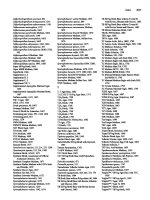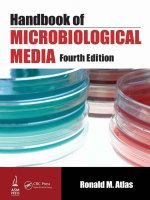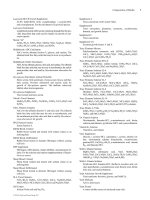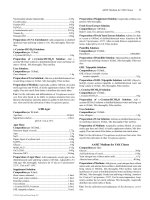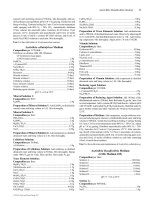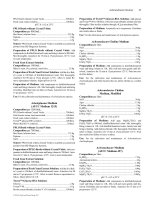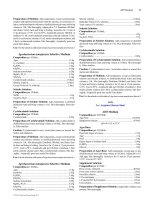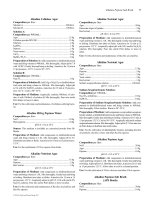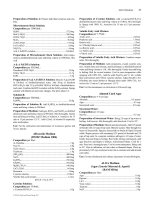Handbook of Microbiological Media, Fourth Edition part 64 pdf
Bạn đang xem bản rút gọn của tài liệu. Xem và tải ngay bản đầy đủ của tài liệu tại đây (222.52 KB, 10 trang )
Ectothiorhodospira halophila Medium 625
NaHCO
3
10.0g
Na
2
CO
3
5.0g
Sodium acetate 1.0g
KH
2
PO
4
0.8g
NH
4
Cl 0.8g
MgCl
2
·6H
2
O 0.1g
Na
2
S·9H
2
O solution 10.0mL
Trace elements solution SLA 1.0mL
Vitamin solution 1.0mL
pH 8.5 ± 0.2 at 25°C
Na
2
S·9H
2
O Solution:
Composition
per 10.0mL:
Na
2
S·9H
2
O 0.5g
Preparation of Na
2
S·9H
2
O Solution: Add Na
2
S·9H
2
O to dis-
tilled/deionized water and bring volume to 10.0mL. Mix thoroughly.
Gas under 100% N
2
. Autoclave for 15 min at 15 psi pressure–121°C.
Trace Elements Solution SLA:
Composition
per liter:
CuCl
2
·2H
2
O 10.0g
FeCl
2
·4H
2
O 1.8g
H
3
BO
3
0.5g
CoCl
2
·6H
2
O 0.25g
ZnCl
2
0.1g
MnCl
2
·4H
2
O 70.0mg
Na
2
MoO
4
·2H
2
O 30.0mg
Na
2
SeO
3
·5H
2
O 10.0mg
NiCl
2
·6H
2
O 10.0mg
Preparation of Trace Elements Solution SLA: Add components
to distilled/deionized water and bring volume to 1.0L. Mix thoroughly.
Adjust pH to 2.0–3.0.
Vitamin Solution VA:
Composition
per 100.0mL:
Nicotinic acid amide 35.0mg
Thiamine dichloride 30.0mg
p-Aminobenzoic acid 20.0mg
Biotin 10.0mg
Calcuim
DL-pantothenate 10.0mg
Pyridoxal·HCl 10.0mg
Vitamin B
12
5.0mg
Preparation of Vitamin Solution VA: Add components to dis-
tilled/deionized water and bring volume to 100.0mL. Mix thoroughly.
Filter sterilize.
Preparation of Medium: Add components, except Na
2
S·9H
2
O so-
lution, to distilled/deionized water and bring volume to 1.0L. Mix thor-
oughly. Adjust pH to 8.5. Filter sterilize. Aseptically add 10.0mL of
sterile Na
2
S·9H
2
O solution. Mix thoroughly. Distribute into sterile
tubes or flasks.
Use: For the cultivation and maintenance of Ectothiorhodospira
abdelmalekii.
Ectothiorhodospira halochloris Medium
Composition per liter:
NaCl 180.0g
Na
2
SO
4
20.0g
NaHCO
3
14.0g
Na
2
CO
3
6.0g
Na
2
S·9H
2
O 1.0g
Sodium succinate 1.0g
NH
4
Cl 0.8g
KH
2
PO
4
0.5g
Yeast extract 0.5g
MgCl
2
·6H
2
O 0.1g
CaCl
2
·2H
2
O 0.05g
Vitamin solution VA 1.0mL
Trace elements solution SLA 1.0mL
pH 8.5–8.7 at 25°C
Vitamin Solution VA:
Composition per liter:
Nicotinamide 0.04g
Thiamine dichloride 0.03g
p-Aminobenzoic acid 0.02g
Biotin 0.01g
Calcium pantothenate 0.01g
Pyridoxal chloride 0.01g
Vitamin B
12
5.0mg
Preparation of Vitamin Solution VA: Add components to dis-
tilled/deionized water and bring volume to 1.0L. Mix thoroughly.
Trace Elements Solution SLA:
Composition per liter:
FeCl
2
·4H
2
O 1.8g
H
3
BO
3
0.5g
CoCl
2
·6H
2
O 0.25g
ZnCl
2
0.1g
MnCl
2
·4H
2
O 0.07g
NaMoO
4
·2H
2
O 0.03g
CuCl
2
·2H
2
O 0.01g
Na
2
SeO
3
0.01g
NiCl
2
·6H
2
0 0.01g
Preparation of Trace Elements Solution SLA: Add compo-
nents to distilled/deionized water and bring volume to 1.0L. Mix thor-
oughly. Adjust pH to 3.0 with 2N HCl.
Preparation of Medium: Add components, except trace elements
solution SLA, to distilled/deionized water and bring volume to
999.0mL. Mix thoroughly. Filter sterilize. Aseptically add 1.0mL of
sterile trace elements solution SLA. Mix thoroughly. Aseptically dis-
tribute into flasks or bottles. Completely fill bottles with medium ex-
cept for a pea-sized air bubble.
Use: For the enrichment and isolation of Ectothiorhodospira hal-
ochloris.
Ectothiorhodospira halophila Medium
Composition per liter:
NaCl 200.0g
NH
4
Cl 0.4g
(NH
4
)
2
SO
4
0.1g
Na
2
CO
3
solution 100.0mL
Tris buffer (1M solution, pH 7.5) 30.0mL
Solution C 5.0mL
Potassium phosphate buffer (1M solution, pH 7.5) 3.0mL
Additional solution 2.5mL
pH 7.4–8.0 at 25°C
Na
2
CO
3
Solution:
Composition per 100.0mL:
Na
2
CO
3
10.0g
© 2010 by Taylor and Francis Group, LLC
626 Ectothiorhodospira halophila Medium
Preparation of Na
2
CO
3
Solution: Add Na
2
CO
3
to distilled/deion-
ized water and bring volume to 100.0mL. Mix thoroughly. Autoclave
for 15 min at 15 psi pressure–121°C. Cool to 25°C.
Solution C:
Composition per liter:
MgCl
2
·6H
2
O 24.0g
CaCl
2
·2H
2
O 3.3g
FeCl
3
·4H
2
O 1.1g
(NH
4
)
6
Mo
7
O
24
·4H
2
O 0.1g
Nitrilotriacetic acid 10.0mg
Trace elements solution 50.0mL
Preparation of Solution C: Add nitrilotriacetic acid to 500.0mL of
distilled/deionized water. Dissolve by adjusting pH to 6.5 with KOH.
Add remaining components. Readjust pH to 7.2 with H
2
SO
4
or KOH.
Add distilled/deionized water to 1.0L.
Trace Elements Solution:
Composition per 100.0mL:
ZnCl
2
0.52g
EDTA 0.25g
MnCl
2
·4H
2
O 0.08g
FeCl
3
·4H
2
O 0.03g
Co(NO
3
)
2
·6H
2
O 0.02g
CuCl
2
·2H
2
O 0.02g
H
3
BO
3
0.01g
Preparation of Trace Elements Solution: Add components to
distilled/deionized water and bring volume to 1.0L. Mix thoroughly.
Adjust pH to 3.0 with 2N HCl.
Additional Solution:
Composition per 50.0mL:
NaS
2
O
3
·6H
2
O 6.0g
Sodium succinate 5.0g
Sodium ascorbate 1.0g
Preparation of Additional Solution: Add components to dis-
tilled/deionized water and bring volume to 50.0mL. Mix thoroughly.
Filter sterilize.
Preparation of Medium: Add components, except Na
2
CO
3
solu-
tion and additional solution, to distilled/deionized water and bring vol-
ume to 900.0mL. Autoclave for 15 min at 15 psi pressure–121°C. Cool
to 45°–50°C. Aseptically adjust pH to 7.4–7.8 with filter-sterilized
HCl. Aseptically distribute into 50.0mL screw-capped bottles. Fill
each bottle almost to the top, leaving a space of 2.8mL in the neck.
Aseptically add 2.5mL of sterile additional solution to each bottle. Mix
thoroughly.
Use: For the isolation and cultivation of Ectothiorhodospira halo-
phila.
Ectothiorhodospira halophila Medium
Composition per liter:
NaCl 220.0g
Potassium succinate 1.0g
Na
2
S·9H
2
O 0.1g
K
2
HPO
4
solution 20.0mL
NaHCO
3
solution 20.0mL
Solution C 20.0mL
(NH
4
)
2
SO
4
solution 5.0mL
Vitamin solution 0.5mL
pH 7.4–8.0 at 25°C
K
2
HPO
4
Solution:
Composition per liter:
K
2
HPO
4
125.0g
Preparation of K
2
HPO
4
Solution: Add K
2
HPO
4
to distilled/de-
ionized water and bring volume to 1.0L. Mix thoroughly.
NaHCO
3
Solution:
Composition per liter:
NaHCO
3
100.0g
Preparation of NaHCO
3
Solution: Add NaHCO
3
to distilled/de-
ionized water and bring volume to 1.0L. Mix thoroughly.
Solution C:
Composition per liter:
MgCl
2
·6H
2
O 24.0g
CaCl
2
·2H
2
O 3.3g
FeCl
3
·4H
2
O 1.1g
(NH
4
)
6
Mo
7
O
24
·4H
2
O 0.1g
Nitrilotriacetic acid 10.0mg
Trace elements solution 50.0mL
Preparation of Solution C: Add components to distilled/deionized
water and bring volume to 1.0L. Mix thoroughly.
Trace Elements Solution:
Composition per 100.0mL:
ZnCl
2
0.52g
EDTA 0.25g
MnCl
2
·4H
2
O 0.08g
FeCl
3
·4H
2
O 0.03g
Co(NO
3
)
2
·6H
2
O 0.02g
CuCl
2
·2H
2
O 0.02g
H
3
BO
3
0.01g
Preparation of Trace Elements Solution: Add components to
distilled/deionized water and bring volume to 1.0L. Mix thoroughly.
Adjust pH to 3.0 with 2N HCl.
(NH
4
)
2
SO
4
Solution:
Composition per liter:
(NH
4
)
2
SO
4
100.0g
Preparation of (NH
4
)
2
SO
4
Solution: Add components to dis-
tilled/deionized water and bring volume to 1.0L. Mix thoroughly.
Vitamin Solution:
Composition per liter:
Nicotinic acid 2.0mg
Thiamine 1.0mg
p-Aminobenzoic acid 0.2mg
Biotin 0.02mg
Vitamin B
12
1.0μg
Preparation of Vitamin Solution: Add components to distilled/
deionized water and bring volume to 1.0L. Mix thoroughly.
Preparation of Medium: Add components to distilled/deionized
water and bring volume to 1.0L. Mix thoroughly. Adjust pH to 7.4–8.0.
Filter sterilize. Aseptically distribute into flasks or bottles. Completely
fill bottles with medium except for a pea-sized air bubble.
Use: For the isolation and cultivation of Ectothiorhodospira halo-
phila.
© 2010 by Taylor and Francis Group, LLC
Ectothiorhodospira Medium 627
Ectothiorhodospira Medium
Composition per liter:
NaCl 180.0g
Na
2
SO
4
20.0g
NaHCO
3
14.0g
Na
2
CO
3
6.0g
Sodium succinate 1.0g
NH
4
Cl 0.8g
KH
2
PO
4
0.5g
MgCl
2
·6H
2
O 0.1g
CaCl
2
·2H
2
O 0.05g
Feeding solution 10.0mL
Trace elements solution SLA 1.0mL
Vitamin solution VA 1.0mL
pH 8.5–8.7 at 25°C
Feeding Solution:
Composition per 100.0mL:
NaCl 10.0g
NaHCO
3
10.0g
Na
2
S·9H
2
O 5.0g
Preparation of Feeding Solution: Add components to distilled/
deionized water and bring volume to 100.0mL. Mix thoroughly. Filter
sterilize.
Trace Elements Solution SLA:
Composition per liter:
FeCl
2
·4H
2
O 1.8g
H
3
BO
3
0.5g
CoCl
2
·6H
2
O 0.25g
ZnCl
2
0.1g
MnCl
2
·4H
2
O 0.07g
NaMoO
4
·2H
2
O 0.03g
CuCl
2
·2H
2
O 0.01g
Na
2
SeO
3
0.01g
NiCl
2
·6H
2
O 0.01g
Preparation of Trace Elements Solution SLA: Add compo-
nents to distilled/deionized water and bring volume to 1.0L. Mix thor-
oughly. Adjust pH to 3.0 with 2N HCl.
Vitamin Solution VA:
Composition per liter:
Nicotinamide 0.04g
Thiamine dichloride 0.03g
p-Aminobenzoic acid 0.02g
Biotin 0.01g
Calcium pantothenate 0.01g
Pyridoxal chloride 0.01g
Vitamin B
12
5.0mg
Preparation of Vitamin Solution VA: Add components to dis-
tilled/deionized water and bring volume to 1.0L. Mix thoroughly.
Preparation of Medium: Add components, except trace elements
solution SLA and feeding solution, to distilled/deionized water and
bring volume to 999.0mL. Mix thoroughly. Filter sterilize. Aseptically
add 1.0mL of sterile trace elements solution SLA. Mix thoroughly.
Aseptically distribute into flasks or bottles. Completely fill bottles with
medium except for a pea-sized air bubble. Prior to inoculation, asepti-
cally remove a sufficient amount of medium to permit the addition of
feeding medium. Add 1.0mL of feeding solution per each 100.0mL of
medium.
Use: For the isolation and cultivation of Ectothiorhodospira halochloris
and Ectothiorhodospira halophila.
Ectothiorhodospira Medium
Composition per liter:
NaCl 130.0g
Na
2
SO
4
10.0g
Sodium acetate 2.0g
KH
2
PO
4
0.8g
Sodium carbonate buffer, (1M, pH 9.0) 200.0mL
MgCl
2
·6H
2
O solution 10.0mL
Na
2
S·9H
2
O solution 6.0mL
CaCl
2
·2H
2
O solution 5.0mL
NH
4
Cl solution 4.0mL
SLA trace elements 1.0mL
VA vitamin solution 1.0mL
pH 9.0 ± 0.2 at 25°C
MgCl
2
·6H
2
O Solution:
Composition
per 10.0mL:
MgCl
2
·6H
2
O 0.1g
Preparation of MgCl
2
·6H
2
O Solution: Add MgCl
2
·6H
2
O to dis-
tilled/deionized water and bring volume to 10.0mL. Mix thoroughly.
Filter sterilize.
Na
2
S·9H
2
O Solution:
Composition
per 10.0mL:
Na
2
S·9H
2
O 0.5g
Preparation of Na
2
S·9H
2
O Solution: Add Na
2
S·9H
2
O to dis-
tilled/deionized water and bring volume to 10.0mL. Mix thoroughly.
Filter sterilize. Use freshly prepared solution.
CaCl
2
·2H
2
O Solution:
Composition
per 10.0mL:
CaCl
2
·2H
2
O 0.1g
Preparation of CaCl
2
·2H
2
O Solution: Add CaCl
2
·2H
2
O to dis-
tilled/deionized water and bring volume to 10.0mL. Mix thoroughly.
Filter sterilize.
NH
4
Cl Solution:
Composition
per 10.0mL:
NH
4
Cl 2.0g
Preparation of NH
4
Cl Solution: Add NH
4
Cl to distilled/deion-
ized water and bring volume to 10.0mL. Mix thoroughly. Filter steril-
ize.
SLA Trace Elements:
Composition
per liter:
FeCl
2
·4H
2
O 1.8g
H
3
BO
3
0.5g
CoCl
2
·6H
2
O 0.25g
ZnCl
2
0.1g
MnCl
2
·4H
2
O 0.07g
Na
2
MoO
4
·2H
2
O 0.03g
CuCl
2
·2H
2
O 0.01g
Na
2
SeO
3
·5H
2
O 0.01g
NiCl
2
·6H
2
O 0.01g
Preparation of SLA Trace Elements: Add components to dis-
tilled/deionized water and bring volume to 1.0L. Mix thoroughly. Ad-
just pH to 2–3.
© 2010 by Taylor and Francis Group, LLC
628 Ectothiorhodospira Medium, Modified
VA Vitamin Solution:
Composition
per 500.0mL:
Nicotinamide 0.175g
Thiamine·HCl 0.15g
p-Aminobenzoic acid 0.1g
Biotin 0.05g
Calcium pantothenate 0.05g
Pyridoxine·2HCl 0.05g
Cyanocobalamin 0.025g
Preparation of VA Vitamin Solution: Add components to dis-
tilled/deionized water and bring volume to 500.0mL. Mix thoroughly.
Preparation of Medium: Add components—except MgCl
2
·6H
2
O
solution, Na
2
S·9H
2
O solution, CaCl
2
·2H
2
O solution, and NH
4
Cl solu-
tion—to distilled/deionized water and bring volume to 975.0mL. Mix
thoroughly. Gently heat and bring to boiling. Autoclave for 15 min at
15 psi pressure–121°C. Cool to 25°C. Aseptically add 10.0mL of ster-
ile MgCl
2
·6H
2
O solution, 6.0mL of sterile Na
2
S·9H
2
O solution, 5.0mL
of sterile CaCl
2
·2H
2
O solution, and 4.0mL of sterile NH
4
Cl solution.
Mix thoroughly. Aseptically distribute into culture bottles. Incubate for
2 days before inoculation.
Use: For the cultivation and maintenance of Ectothiorhodospira
abdelmalekii and Ectothiorhodospira halochloris.
Ectothiorhodospira Medium, Modified
Composition per liter:
NaCl 30.0g
Na
2
SO
4
10.0g
Sodium acetate 2.0g
KH
2
PO
4
0.8g
Sodium carbonate buffer (1M, pH 9.0) 200.0mL
MgCl
2
·6H
2
O solution 10.0mL
Na
2
S·9H
2
O solution 6.0mL
CaCl
2
·2H
2
O solution 5.0mL
NH
4
Cl solution 4.0mL
SLA trace elements 1.0mL
VA vitamin solution 1.0mL
pH 9.0 ± 0.2 at 25°C
MgCl
2
·6H
2
O Solution:
Composition
per 10.0mL:
MgCl
2
·6H
2
O 0.1g
Preparation of MgCl
2
·6H
2
O Solution: Add MgCl
2
·6H
2
O to dis-
tilled/deionized water and bring volume to 10.0mL. Mix thoroughly.
Filter sterilize.
Na
2
S·9H
2
O Solution:
Composition
per 10.0mL:
Na
2
S·9H
2
O 0.5g
Preparation of Na
2
S·9H
2
O Solution: Add Na
2
S·9H
2
O to dis-
tilled/deionized water and bring volume to 10.0mL. Mix thoroughly.
Filter sterilize. Use freshly prepared solution.
CaCl
2
·2H
2
O Solution:
Composition
per 10.0mL:
CaCl
2
·2H
2
O 0.1g
Preparation of CaCl
2
·2H
2
O Solution: Add CaCl
2
·2H
2
O to dis-
tilled/deionized water and bring volume to 10.0mL. Mix thoroughly.
Filter sterilize.
NH
4
Cl Solution:
Composition
per 10.0mL:
NH
4
Cl 2.0g
Preparation of NH
4
Cl Solution: Add NH
4
Cl to distilled/deion-
ized water and bring volume to 10.0mL. Mix thoroughly. Filter steril-
ize.
SLA Trace Elements:
Composition
per liter:
FeCl
2
·4H
2
O 1.8g
H
3
BO
3
0.5g
CoCl
2
·6H
2
O 0.25g
ZnCl
2
0.1g
MnCl
2
·4H
2
O 0.07g
Na
2
MoO
4
·2H
2
O 0.03g
CuCl
2
·2H
2
O 0.01g
Na
2
SeO
3
·5H
2
O 0.01g
NiCl
2
·6H
2
O 0.01g
Preparation of SLA Trace Elements: Add components to dis-
tilled/deionized water and bring volume to 1.0L. Mix thoroughly. Ad-
just pH to 2–3.
VA Vitamin Solution:
Composition
per 500.0mL:
Nicotinamide 0.175g
Thiamine·HCl 0.15g
p-Aminobenzoic acid 0.1g
Biotin 0.05g
Calcium pantothenate 0.05g
Pyridoxine·2HCl 0.05g
Cyanocobalamin 0.025g
Preparation of VA Vitamin Solution: Add components to dis-
tilled/deionized water and bring volume to 500.0mL. Mix thoroughly.
Preparation of Medium: Add components—except MgCl
2
·6H
2
O
solution, Na
2
S·9H
2
O solution, CaCl
2
·2H
2
O solution, and NH
4
Cl solu-
tion—to distilled/deionized water and bring volume to 975.0mL. Mix
thoroughly. Gently heat and bring to boiling. Autoclave for 15 min at
15 psi pressure–121°C. Cool to 25°C. Aseptically add 10.0mL of ster-
ile MgCl
2
·6H
2
O solution, 6.0mL of sterile Na
2
S·9H
2
O solution, 5.0mL
of sterile CaCl
2
·2H
2
O solution, and 4.0mL of sterile NH
4
Cl solution.
Mix thoroughly. Aseptically distribute into culture bottles. Incubate for
2 days before inoculation.
Use: For the cultivation and maintenance of Ectothiorhodospira vac-
uolata.
Ectothiorhodospira vacuolata Medium
Composition per 1002.0mL:
NaCl 30.0g
NaHCO
3
3.0g
KH
2
PO
4
1.0g
Sodium malate 1.0g
Na
2
SO
3
·5H
2
O 0.5g
NH
4
Cl 0.5g
MgCl
2
·6H
2
O 0.2g
CaCl
2
·2H
2
O 0.1g
Na
2
S·9H
2
O solution 10.0mL
Trace elements solution SLA 1.0mL
Vitamin solution VA 1.0mL
pH 8.7 ± 0.2 at 25°C
© 2010 by Taylor and Francis Group, LLC
Ectothiorhodosynus Medium 629
Na
2
S·9H
2
O Solution:
Composition
per 10.0mL:
Na
2
S·9H
2
O 0.5g
Preparation of Na
2
S·9H
2
O Solution: Add Na
2
S·9H
2
O to dis-
tilled/deionized water and bring volume to 10.0mL. Mix thoroughly.
Gas under 100% N
2
. Autoclave for 15 min at 15 psi pressure–121°C.
Trace Elements Solution SLA:
Composition
per liter:
CuCl
2
·2H
2
O 10.0g
FeCl
2
·4H
2
O 1.8g
H
3
BO
3
0.5g
CoCl
2
·6H
2
O 0.25g
ZnCl
2
0.1g
MnCl
2
·4H
2
O 70.0mg
Na
2
MoO
4
·2H
2
O 30.0mg
Na
2
SeO
3
·5H
2
O 10.0mg
NiCl
2
·6H
2
O 10.0mg
Preparation of Trace Elements Solution SLA: Add components
to distilled/deionized water and bring volume to 1.0L. Mix thoroughly.
Adjust pH to 2.0–3.0.
Vitamin Solution VA:
Composition
per 100.0mL:
Nicotinic acid amide 35.0mg
Thiamine dichloride 30.0mg
p-Aminobenzoic acid 20.0mg
Biotin 10.0mg
Calcium
DL-pantothenate 10.0mg
Pyridoxal·HCl 10.0mg
Vitamin B
12
5.0mg
Preparation of Vitamin Solution VA: Add components to dis-
tilled/deionized water and bring volume to 100.0mL. Mix thoroughly.
Filter sterilize.
Preparation of Medium: Add components, except Na
2
S·9H
2
O so-
lution, to distilled/deionized water and bring volume to 1.0L. Mix thor-
oughly. Adjust pH to 8.7. Filter sterilize. Aseptically add 10.0mL of
sterile Na
2
S·9H
2
O solution. Mix thoroughly. Distribute into sterile
tubes or flasks.
Use: For the cultivation and maintenance of Ectothiorhodospira vac-
uolata.
Ectothiorhodosynus Medium
(DSMZ Medium 1002)
Composition per liter:
NaCl 20.0g
Na-acetate 1.0g
K
2
HPO
4
0.5g
Na
2
S
2
O
3
0.5g
MgCl
2
·6H
2
O 0.2g
Yeast extract 0.1g
Vitamin B
12
0.02mg
Ammonium chloride solution 10.0mL
Calcium chloride solution 10.0mL
Sodium carbonate solution 10.0mL
Sodium bicarbonate solution 10.0mL
Na
2
S·9H
2
O solution 10.0mL
Trace elements SL-6 solution 1.0mL
pH 9.3 ± 0.2 at 25°C
Trace Elements SL-6 Solution:
Composition
per liter:
H
3
BO
3
0.3g
CoCl
2
·6H
2
O 0.2g
ZnSO
4
·7H
2
O 0.1g
MnCl
2
·4H
2
O 0.03g
Na
2
MoO
4
·H
2
O 0.03g
NiCl
2
·6H
2
O 0.02g
CuCl
2
·2H
2
O 0.01g
Preparation of Trace Elements SL-6 Solution: Add components
to distilled/deionized water and bring volume to 1.0L. Mix thoroughly.
Adjust pH to 3.4.
Na
2
S·9H
2
O Solution:
Composition per 10.0mL:
Na
2
S·9H
2
O 0.24g
Preparation of Na
2
S·9H
2
O Solution: Add Na
2
S·9H
2
O to dis-
tilled/deionized water and bring volume to 10.0mL. Mix thoroughly.
Autoclave under 100% N
2
for 15 min at 15 psi pressure–121°C. Cool
to room temperature.
Sodium Bicarbonate Solution:
Composition per 10.0mL:
NaHCO
3
5.0g
Preparation of Sodium Bicarbonate Solution: Add compo-
nents to distilled/deionized water and bring volume to 10.0mL. Mix
thoroughly. Filter sterilize.
Sodium Carbonate Solution:
Composition
per 10.0mL:
Na
2
CO
3
5.0g
Preparation of Sodium Carbonate Solution: Add components
to distilled/deionized water and bring volume to 10.0mL. Mix thor-
oughly. Autoclave for 15 min at 15 psi pressure–121°C.
Calcium Chloride Solution:
Composition
per 10.0mL:
CaCl
2
·2H
2
O 0.1g
Preparation of Calcium Chloride Solution: Add components to
distilled/deionized water and bring volume to 1.0L. Mix thoroughly.
Autoclave for 15 min at 15 psi pressure–121°C.
Ammonium Chloride Solution:
Composition
per 10.0mL:
NH
4
Cl 0.5g
Preparation of Ammonium Chloride Solution: Add compo-
nents to distilled/deionized water and bring volume to 10.0mL. Mix
thoroughly. Autoclave for 15 min at 15 psi pressure–121°C.
Preparation of Medium: Add components, except ammonium
chloride, calcium chloride, carbonate, bicarbonate, and sulfide solu-
tions, to distilled/deionized water and bring volume to 950.0mL. Mix
thoroughly. Adjust pH to 9.3. Gently heat while stirring and bring to
boiling. Distribute into tubes or flasks. Autoclave for 15 min at 15 psi
pressure–121°C. Aseptically add the ammonium chloride, calcium
chloride, carbonate, bicarbonate, and sulfide solutions. Mix thorough-
ly. Aseptically distribute into sterile tubes or flasks.
Use: For the cultivation of Ectothiorhodosynus spp.
Edelstein BMPA-α Medium
See: BMPA-α Medium
© 2010 by Taylor and Francis Group, LLC
630 Edwards Medium HiVeg Base, Modified
Edwards Medium HiVeg Base, Modified
Composition per liter:
Agar 15.0g
Plant extract 10.0g
Plant peptone 10.0g
NaCl 5.0g
Esculin 1.0g
Thallous sulfate 0.33g
Crystal Violet 1.3mg
Sterile bovine or sheep blood 50.0mL
pH 7.4 ± 0.2 at 25°C
Source: This medium, without blood, is available as a premixed pow-
der from HiMedia.
Preparation of Medium: Add components, except blood, to dis-
tilled/deionized water and bring volume to 950.0mL. Mix thoroughly.
Gently heat and bring to boiling. Autoclave for 20 min at 10 psi pres-
sure–115°C. Cool to 45°–50°C. Aseptically add 50.0mL of sterile bo-
vine blood or sheep blood. Mix thoroughly. Pour into sterile Petri
dishes.
Use: For the selective isolation and cultivation of Streptococcus aga-
lactiae and other streptococci involved in bovine mastitis.
Edwards and Bruner Semisolid Medium
Composition per liter:
Gelatin 80.0g
Peptic digest of animal tissue 10.0g
NaCl 5.0g
Agar 4.0g
Beef extract 3.0g
pH 6.9 ± 0.2 at 25°C
Preparation of Medium: Add components to distilled/deionized
water and bring volume to 1.0L. Mix thoroughly. Gently heat and bring
to boiling. Distribute into tubes or flasks. Autoclave for 15 min at 15
psi pressure–121°C. Pour into sterile Petri dishes or leave in tubes.
Use: For the detection of motility and separation of H and O phases of
enteric bacilli.
Edwards Medium, Modified
Composition per liter:
Agar 15.0g
Beef extract 10.0g
Peptone 10.0g
NaCl 5.0g
Esculin 1.0g
Tl
2
SO
4
0.33g
Crystal Violet 1.3mg
Bovine or sheep blood 50.0mL
pH 7.4 ± 0.2 at 25°C
Source: This medium is available as a premixed powder from Oxoid.
Preparation of Medium: Add components, except blood, to dis-
tilled/deionized water and bring volume to 950.0mL. Mix thoroughly.
Gently heat and bring to boiling. Autoclave for 20 min at 10 psi pres-
sure–115°C. Cool to 45°–50°C. Aseptically add 50.0mL of sterile bo-
vine blood or sheep blood. Mix thoroughly. Pour into sterile Petri
dishes.
Use: For the selective isolation and cultivation of Streptococcus aga-
lactiae and other streptococci involved in bovine mastitis.
Edwards Medium, Modified
Composition per 1060.0mL:
Agar 15.0g
Lab Lemco powder 10.0g
Peptone 10.0g
NaCl 5.0g
Esculin 1.0g
Tl
2
SO
4
0.33g
Crystal Violet 0.0013g
Blood, bovine or sheep 60.0mL
pH 7.4 ± 0.2 at 25°C
Source: This medium is available as a premixed powder from Oxoid
Unipath.
Caution: Thallous sulfate is toxic.
Preparation of Medium: Add components, except blood, to dis-
tilled/deionized water and bring volume to 1.0L. Mix thoroughly. Gen-
tly heat while stirring and bring to boiling. Autoclave for 20 min at 15
psi pressure–121°C. Cool to 50°C. Aeptically add 60.0mL sterile bo-
vine or sheep blood. Mix thoroughly. Pour into sterile Petri dishes.
Use: For the rapid isolation of Streptococcus agalactiae and other
streptococci involved in bovine mastitis. Esculin differentiates the neg-
ative Streptococcus agalactiae, which form blue colonies, from escu-
lin-positive Group D streptococci, which form black colonies.
EE Broth
(Enterobacteriaceae Enrichment Broth)
Composition per liter:
Ox bile 20.0g
Peptone 10.0g
Na
2
HPO
4
6.45g
Glucose 5.0g
KH
2
PO
4
2.0g
Brilliant Green 0.0135g
pH 7.2 ± 0.2
at 25°C
Source: This medium is available as a premixed powder from Oxoid.
Preparation of Medium: Add components to distilled/deionized
water and bring volume to 1.0L. Mix thoroughly. Distribute into flasks
in 100.0mL volumes. Gently heat at 100°C for 30 min. Do not auto-
clave. Cool rapidly to 25°C.
Use: For the cultivation and enrichment of members of the Enterobac-
teriaceae in the examination of foods and animal feed. Used in con-
junction with tryptone soy broth. Bacteria belonging to the Enterobac-
teriaceae turn this medium turbid and yellow-green.
EE Broth, HiVeg
Composition per liter:
Plant peptone 25.0g
Na
2
HPO
4
6.45g
Glucose 5.0g
Synthetic detergent No. II 5.0g
KH
2
PO
4
2.0g
Brilliant Green 13.5mg
pH 7.2 ± 0.2
at 25°C
Source: This medium is available as a premixed powder from Hi-
Media.
Preparation of Medium: Add components to distilled/deionized
water and bring volume to 1.0L. Mix thoroughly. Distribute into flasks
© 2010 by Taylor and Francis Group, LLC
EG Sodium Chloride Medium No. 7 631
in 100.0mL volumes. Gently heat at 100°C for 30 min. Do not auto-
clave. Cool rapidly to 25°C.
Use: For the cultivation and enrichment of members of the Enterobac-
teriaceae in the examination of foods and animal feed. Used in con-
junction with tryptone soy broth. Bacteria belonging to the Enterobac-
teriaceae turn this medium turbid and yellow-green.
EE Broth, Mossel
(Enterobacteriaceae Enrichment Broth, Mossel)
Composition per liter:
Enzymatic hydrolysate of protein 10.0g
Na
2
HPO
4
8.0g
Glucose 5.0g
KH
2
PO
4
2.0g
Oxgall 0.1g
Brilliant Green 0.0135g
pH 7.2 ± 0.2 at 25°C
Source: This medium is available as a premixed powder from BD Di-
agnostic Systems.
Preparation of Medium: Add components to distilled/deionized
water and bring volume to 1.0L. Mix thoroughly. Distribute into flasks
in 120.0mL volumes. Gently heat at 100°C for 30 min. Do not auto-
clave. Cool rapidly to 25°C.
Use: For the cultivation and enrichment of members of the Enteroba-
teriaceae in the examination of foods and animal feed. Used in con-
junction with tryptone soy broth. Bacteria belonging to the Enterobac-
teriaceae turn this medium turbid and yellow-green.
EE HiVeg Broth, Mossel
Composition per liter:
Oxbile 20.0g
Peptic digest of animal tissue 10.0g
Na
2
HPO
4
, dihydrate 6.45g
Glucose 5.0g
KH
2
PO
4
2.0g
Brilliant Green 15.0mg
pH 7.2 ± 0.2
at 25°C
Source: This medium is available as a premixed powder from Hi-
Media.
Preparation of Medium: Add components to distilled/deionized
water and bring volume to 1.0L. Mix thoroughly. Distribute into flasks
in 100.0mL volumes. Gently heat at 100°C for 30 min. Do not auto-
clave. Cool rapidly to 25°C.
Use: For the cultivation and enrichment of members of the Enterobac-
teriaceae in the examination of foods and animal feed.
EE HiVeg Broth, Modified
Composition per liter:
Plant peptone No. 2 25.0g
Na
2
HPO
4
, dihydrate 8.0g
Glucose monohydrate 5.0g
Synthetic detergent No. II 5.0g
KH
2
PO
4
2.0g
Brilliant Green 15.0mg
pH 7.2 ± 0.2
at 25°C
Source: This medium is available as a premixed powder from Hi-
Media.
Preparation of Medium: Add components to distilled/deionized
water and bring volume to 1.0L. Mix thoroughly. Distribute into flasks
in 100.0mL volumes. Gently heat at 100°C for 30 min. Do not auto-
clave. Cool rapidly to 25°C.
Use: For the cultivation and enrichment of members of the Enterobac-
teriaceae in the examination of foods and animal feed. Used in con-
junction with tryptone soy broth. Bacteria belonging to the Enterobac-
teriaceae turn this medium turbid and yellow-green.
EG Agar
Composition per 1055.0mL:
Agar 15.0g
Proteose peptone No. 3 10.0g
Yeast extract 5.0g
Na
2
HPO
4
4.0g
Lab Lemco meat extract 2.4g
Glucose 1.5g
L-Cysteine·HCl·H
2
O 0.5g
Soluble starch 0.5g
L-Cystine 0.2g
Horse blood 50.0mL
HCl (1N solution) 50.0mL
10% Silicone SH 5535 5.0mL
pH 7.6–7.8
at 25°C
Source: Lab Lemco meat extract is available from Oxoid Unipath.
10% Silicone SH 5535 is available from Toray. Proteose peptone No.
3 is available from BD Diagnostic Systems.
Preparation of Medium: Add L-cystine to 50.0mL of 1N HCl. Mix
thoroughly. Add remaining components and bring volume to 950.0mL.
Mix thoroughly. Autoclave for 15 min at 15 psi pressure–121°C. Cool
to 50°–55°C. Aseptically add 50.0mL of horse blood. Mix thoroughly.
Pour into sterile Petri dishes or distribute into sterile tubes.
Use: For the cultivation of Actinomyces naeslundii, Actinomyces visco-
sus, Bacteroides species, Bifidobacterium species, Campylobacter spe-
cies, Clostridium species, Eubacterium species, Fusobacterium necro-
phorum, Fusobacterium nucleatum, Fusobacterium pseudonecro-
phorum, Lactobacillus species, Megasphaera cerevisiae, Megasphaera
elsdenii, Mitsuokella multiacida, Peptostreptococcus species, Prevotella
species, Propionibacterium species, Rikenella microfusus, Selenomonas
species, and Wolinella recta.
EG Medium
Pancreatic digest of casein 2.0g
Yeast extract 2.0g
Beef extract 1.0g
Sodium acetate 1.0g
CaCl
2
0.01g
Preparation of Medium: Add components to distilled/deionized
water and bring volume to 1.0L. Mix thoroughly. Distribute into tubes
or flasks. Autoclave for 20 min at 15 psi pressure–121°C.
Use: For the cultivation of Khawkinea quartana.
EG Sodium Chloride Medium No. 7
(Ethylene Glycol NaCl Medium No. 7)
Composition per liter:
NaCl 70.0g
Agar 15.0g
K
2
HPO
4
7.5g
© 2010 by Taylor and Francis Group, LLC
632 Egg Meat Medium
KH
2
PO
4
1.0g
(NH
4
)
2
SO
4
0.8g
MgSO
4
·7H
2
O 0.1g
FeSO
4
·7H
2
O 0.01g
Ethylene glycol 10.0mL
Salt solution 1.0mL
Salt Solution:
Composition
per liter:
CaCl
2
·2H
2
O 6.0g
ZnSO
4
·7H
2
O 4.4g
MnSO
4
·H
2
O 3.0g
(NH
4
)
6
Mo
7
O
24
·4H
2
O 1.82g
CuCl
2
·2H
2
O 0.2g
Preparation of Salt Solution: Add components to distilled/deion-
ized water and bring volume to 1.0L. Mix thoroughly.
Preparation of Medium: Add components to distilled/deionized
water and bring volume to 1.0L. Mix thoroughly. Gently heat and bring
to boiling. Distribute into tubes or flasks. Autoclave for 15 min at 15
psi pressure–121°C. Pour into sterile Petri dishes or leave in tubes.
Use: For the cultivation of ATCC strain 27042.
Egg Meat Medium
Composition per liter:
Beef muscles 454.0g
Egg white 6.0g
CaCO
3
5.0g
pH 7.2 ± 0.2 at 25°C
Source: This medium is available from HiMedia.
Preparation of Medium: Add components to distilled/deionized
water and bring volume to 1.0L. Mix thoroughly. Gently heat and bring
to boiling. Distribute into tubes or flasks. Autoclave for 15 min at 15
psi pressure–121°C.
Use: For the determination of proteolytic activity of anaerobic micro-
organisms. For the maintenance of anaerobic bacteria.
Egg Tellurite Glycine Pyruvate Agar
See: ETGPA
Egg Yolk Agar
Composition per liter:
Proteose peptone No. 2 40.0g
Agar 25.0g
Na
2
HPO
4
5.0g
Glucose 2.0g
NaCl 2.0g
KH
2
PO
4
1.0g
MgSO
4
·7H
2
O 0.1g
Egg yolk emulsion 100.0mL
Hemin solution 1.0mL
pH 7.6 ± 0.2 at 25°C
Hemin Solution:
Composition
per 100.0mL:
Hemin 0.5g
NaOH (1N solution) 20.0mL
Preparation of Hemin Solution: Add hemin to 20.0mL of 1N
NaOH solution. Mix thoroughly. Bring volume to 100.0mL with dis-
tilled/deionized water.
Egg Yolk Emulsion:
Composition
:
Chicken egg yolks 11
Whole chicken egg 1
Preparation of Egg Yolk Emulsion: Soak eggs with 1:100 dilu-
tion of saturated mercuric chloride solution for 1 min. Crack eggs and
separate yolks from whites. Mix egg yolks with 1 chicken egg.
Preparation of Medium: Add components, except egg yolk emul-
sion, to distilled/deionized water and bring volume to 900.0mL. Mix
thoroughly. Gently heat and bring to boiling. Autoclave for 15 min at
15 psi pressure–121°C. Cool to 45°–50°C. Aseptically add sterile egg
yolk emulsion. Mix thoroughly. Pour into sterile Petri dishes.
Use: For the isolation, cultivation, and differentiation of Clostridium spe-
cies and some other anaerobic bacteria.
Egg Yolk Agar Base, HiVeg with Egg Yolk Emulsion
Composition per liter:
Plant peptone No. 3 40.0g
Agar 25.0g
Na
2
HPO
4
5.0g
Glucose 2.0g
NaCl 2.0g
KH
2
PO
4
1.0g
MgSO
4
0.1g
Fe
4
(P
2
O
7
)
3
·H
2
O 5.0mg
Egg yolk emulsion 100.0mL
pH 7.6 ± 0.2 at 25°C
Source: This medium, without egg yolk emulsion, is available as a
premixed powder from HiMedia.
Egg Yolk Emulsion:
Composition
per liter:
Egg yolks 30.0mL
NaCl, 0.9% solution 70.0mL
Preparation of Egg Yolk Emulsion: Soak eggs with 1:100 dilu-
tion of saturated mercuric chloride solution for 1 min. Crack 11 eggs
and separate yolks from whites. Mix egg yolks. Measure 30.0mL of
egg yolk emulsion and add to 70.0mL of 0.9% sterile NaCl solution.
Mix thoroughly. Warm to 45°–50°C.
Preparation of Medium: Add components, except egg yolk emul-
sion, to distilled/deionized water and bring volume to 900.0mL. Mix
thoroughly. Gently heat and bring to boiling. Autoclave for 15 min at
15 psi pressure–121°C. Cool to 45°–50°C. Aseptically add sterile egg
yolk emulsion. Mix thoroughly. Pour into sterile Petri dishes.
Use: For the isolation, cultivation, and differentiation of Clostridium spe-
cies and some other anaerobic bacteria.
Egg Yolk Agar, Lombard-Dowell
See: Lombard-Dowell Egg Yolk Agar
Egg Yolk Agar, Modified
Composition per liter:
Agar 20.0g
Pancreatic digest of casein 15.0g
Vitamin K
1
10.0g
NaCl 5.0g
Papaic digest of soybean meal 5.0g
Yeast extract 5.0g
L-Cystine 0.4g
© 2010 by Taylor and Francis Group, LLC
EGGC 633
Hemin 5.0mg
Egg yolk emulsion 100.0mL
Source: This medium is available as a prepared medium from BD Di-
agnostic Systems.
Egg Yolk Emulsion:
Composition
:
Chicken egg yolks 11
Whole chicken egg 1
Preparation of Egg Yolk Emulsion: Soak eggs with 1:100 dilu-
tion of saturated mercuric chloride solution for 1 min. Crack eggs and
separate yolks from whites. Mix egg yolks with 1 chicken egg.
Preparation of Medium: Add components, except egg yolk emul-
sion, to distilled/deionized water and bring volume to 900.0mL. Mix
thoroughly. Gently heat and bring to boiling. Autoclave for 15 min at
15 psi pressure–121°C. Cool to 45°–50°C. Aseptically add sterile egg
yolk emulsion. Mix thoroughly. Pour into sterile Petri dishes.
Use: For the isolation, cultivation, and differentiation of Clostridium
species and some other anaerobic bacteria.
Egg Yolk Agar with Neomycin
See: Lombard-Dowell Neomycin Agar
Egg Yolk Emulsion
Composition per 100.0mL:
Sterile saline 70.0mL
Egg yolk 30.0mL
Source: Sterile egg yolk emulsion is available from Fluka, Sigma-
Aldrich.
Preparation of Medium: Use fresh eggs, less than 1 week old. Scrub
the shells with soap. Let stand in a soap solution for 30 min. Rinse in run-
ning water. Soak eggs in 70% ethanol for 15 min. or soak eggs with 1:100
dilution of saturated mercuric chloride solution for 1 min. Crack eggs
and separate yolks from whites, placing egg yolks into a sterile contain-
er. Use enough eggs to produce at least 30.0mL egg yolk. Homogenize
by shaking. Add 0.9g NaCl to distilled/deionized water and bring vol-
ume to 100.0mL. Sterilze the saline solution by filtration or by auto-
claving for 15 min at 15 psi pressure–121°C. If autoclaving is used,
cool to 25°C. Aseptically add 30.0mL homogenized egg yolks to
70.0mL of sterile saline solution. Mix thoroughly.
Use: Sterile stabilized emulsion of egg yolk is recommended for use
in various culture media.
Egg Yolk Emulsion
Composition per 100.0mL:
NaCl 0.45g
Egg yolk 50.0mL
Preparation of Medium: Use fresh eggs, less than 1 week old. Scrub
the shells with soap. Let stand in a soap solution for 30 min. Rinse in run-
ning water. Soak eggs in 70% ethanol for 15 min. or soak eggs with 1:100
dilution of saturated mercuric chloride solution for 1 min. Crack eggs
and separate yolks from whites, placing egg yolks into a sterile contain-
er. Use enough eggs to produce at least 50.0mL egg yolk. Homogenize
by shaking. Add 0.45g NaCl to distilled/deionized water and bring vol-
ume to 50.0mL. Sterilize the saline solution by filtration or by auto-
claving for 15 min at 15 psi pressure–121°C. If autoclaving is used,
cool to 25°C. Aseptically add 50.0mL homogenized egg yolks to
50.0mL of the sterile NaCl solution. Mix thoroughly.
Use: Sterile stabilized emulsion of egg yolk is recommended for use
in various culture media.
Egg Yolk Emulsion, 50%
(BAM M51)
Composition per 100.0mL:
Chicken egg yolks variable
NaCl (0.85% solution) 40.0mL
Preparation of Egg Yolk Emulsion: Wash fresh eggs with a stiff
brush and drain. Soak eggs in 70% ethanol for 1 h. Crack eggs asepti-
cally and separate yolks from whites. Remove egg yolks with a sterile
syringe or a wide-mouth pipet. Place 50.0mL of egg yolks into a sterile
container. Add 50.0mL sterile 0.85% saline.
Use: For use in media requiring egg yolk emulsion.
Egg Yolk Tellurite Emulsion 20%
Composition per 100.0mL:
NaCl 0.425g
K
2
TeO
3
0.21g
Egg yolk 20.0mL
Preparation of Medium: Use fresh eggs, less than 1 week old. Scrub
the shells with soap. Let stand in a soap solution for 30 min. Rinse in run-
ning water. Soak eggs in 70% ethanol for 15 min or soak eggs with 1:100
dilution of saturated mercuric chloride solution for 1 min. Crack eggs
and separate yolks from whites, placing egg yolks into a sterile contain-
er. Use enough eggs to produce at least 20.0mL egg yolk. Homogenize
by shaking. Add 0.45g NaCl and 0.21g K
2
TeO
3
to distilled/deionized
water and bring volume to 80.0mL. Sterilize the saline-tellurite solu-
tion by filtration or by autoclaving for 15 min at 15 psi pressure–
121°C. If autoclaving is used, cool to 25°C. Aseptically add 20.0mL
homogenized egg yolks to 80.0mL of the sterile saline-tellurite solu-
tion. Mix thoroughly.
Use: For use in various culture media. It may be added directly to
nutrient media for the identification of Clostridium, Bacillus, and
Staphylococcus species by their lipase activity.
EGGC
(DSMZ Medium 1191)
Composition per liter:
Agar 15.0g
Glucose 0.6g
Na-acetate 0.3g
Casamino acids 0.3g
Salt solution 10.0mL
Vitamin solution 5.0mL
Phosphate soltution 2.0mL
pH 7.2 ± 0.2 at 25°C
Salt Solution:
Composition
per liter:
(NH
4
)
2
SO
4
1.0g
KCl 0.5g
MgSO
4
·7H
2
O 0.5g
CaCl
2
·2H
2
O 0.2g
CaCO
3
0.2g
FeCl
3
·6H
2
O 0.005g
Preparation of Salt Solution: Add components to distilled/deion-
ized water and bring volume to 1.0L. Mix thoroughly.
© 2010 by Taylor and Francis Group, LLC
634 EIA Substrate
Vitamin Solution:
Composition
per100.0mL:
Thiamine-HCl·2H
2
O 50.0mg
Nicotinic acid 50.0mg
Pyridoxine-HCl 50.0mg
D-Ca-pantothenate 50.0mg
Riboflavin 10.0mg
Vitamin B
12
1.0mg
Folic acid 0.2mg
Biotin 0.1mg
Preparation of Vitamin Solution: Add components to distilled/
deionized water and bring volume to 100.0mL. Mix thoroughly. Sparge
with 80% H
2
+ 20% CO
2
. Filter sterilize.
Phosphate Solution:
Composition
per 20.0mL:
Na
2
HPO
4
2.48g
NaH
2
PO
4
0.308g
Preparation of Phosphate Solution: Add components to dis-
tilled/deionized water and bring volume to 20.0mL. Mix thoroughly.
Filter sterilize.
Preparation of Medium: Add components, except phosphate and
vitamin solutions, to distilled/deionized water and bring volume to
980.0mL. Mix thoroughly. Adjust pH to 7.2. Gently heat while stirring
and bring to boiling. Distribute into tubes or flasks. Autoclave for 15
min at 15 psi pressure–121°C. Cool to 50°C. Aseptically add the vita-
min and phosphate solutions. Mix thoroughly. Pour into Petri dishes or
aseptically distribute into sterile tubes.
Use: For the cultivation of Thiothrix spp.
EIA Substrate
Composition per liter:
Agar 15.0g
Esculin 1.0g
Ferric citrate 0.5g
pH 7.1 ± 0.1 at 25°C
Source: This medium is available as a premixed powder from BD Di-
agnostic Systems.
Preparation of Medium: Add components to distilled/deionized
water and bring volume to 1.0L. Mix thoroughly. Gently heat and bring
to boiling. Adjust pH to 7.1. Distribute into tubes or flasks. Autoclave
for 15 min at 15 psi pressure–121°C. Pour into sterile Petri dishes.
Use: For the cultivation and enumeration of marine enterococci by the
membrane filter method.
Eijkman Lactose HiVeg Broth
Composition per liter:
Plant hydrolysate No. 1 15.0g
NaCl 5.0g
K
2
HPO
4
4.0g
Lactose 3.0g
KH
2
PO
4
1.5g
pH 6.8 ± 0.1 at 25°C
Source: This medium is available as a premixed powder from Hi-
Media.
Preparation of Medium: Add components to distilled/deionized
water and bring volume to 1.0L. Mix thoroughly. Distribute into test
tubes that contain an inverted Durham tube. Autoclave for 15 min at 15
psi pressure–121°C.
Use: For the cultivation and differentiation of Escherichia coli from
other coliform organisms based on their ability to ferment lactose and
produce gas.
Eijkman Lactose Medium
Composition per liter:
Pancreatic digest of casein 15.0g
K
2
HPO
4
10.0g
KH
2
PO
4
4.0g
Lactose 3.0g
NaCl 2.5g
pH 6.8 ± 0.1 at 25°C
Preparation of Medium: Add components to distilled/deionized
water and bring volume to 1.0L. Mix thoroughly. Distribute into test
tubes that contain an inverted Durham tube. Autoclave for 15 min at 15
psi pressure–121°C.
Use: For the cultivation and differentiation of Escherichia coli from
other coliform organisms based on their ability to ferment lactose and
produce gas.
Eijkman Lactose Medium
Composition per liter:
Tryptose 15.0g
NaCl 5.0g
K
2
HPO
4
4.0g
Lactose 3.0g
KH
2
PO
4
1.5g
pH 6.8 ± 0.1 at 25°C
Preparation of Medium: Add components to distilled/deionized
water and bring volume to 1.0L. Mix thoroughly. Distribute into test
tubes that contain an inverted Durham tube. Autoclave for 15 min at 15
psi pressure–121°C.
Use: For the cultivation and differentiation of Escherichia coli from
other coliform organisms based on their ability to ferment lactose and
produce gas.
Ekho Lake Strains Medium
(DSMZ Medium 621a)
Composition per liter:
Agar 15.0g
Peptone 0.25g
Yeast extract 0.25g
Artificial sea water 250.0mL
Hutner's basal salts solution 20.0mL
Glucose solution 10.0mL
Vitamin solution 5.0mL
pH 7.3 ± 0.2 at 25°C
Hutner’s Basal Salts Solution:
Composition
per liter:
MgSO
4
·7H
2
O 29.7g
Nitrilotriacetic acid 10.0g
CaCl
2
·2H
2
O 3.335g
FeSO
4
·7H
2
O 99.0mg
(NH
4
)
6
MoO
7
O
24
·4H
2
O 9.25mg
"Metals 44" 50.0mL
© 2010 by Taylor and Francis Group, LLC
